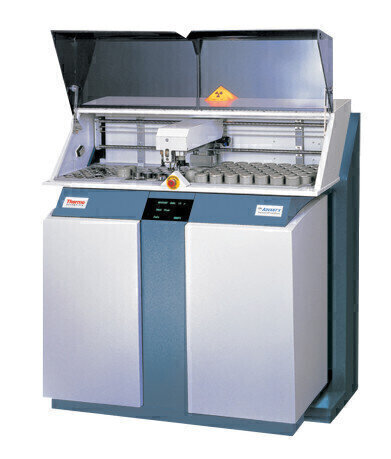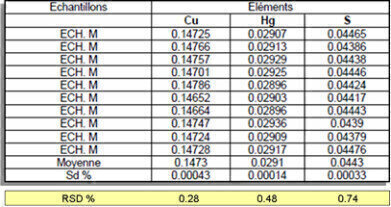-

-
 Table 1: RSD repeatability values on Pt and Cl in FCC catalysts.
Table 1: RSD repeatability values on Pt and Cl in FCC catalysts. -
 Figure 1: Calibration curve for sulfur in dicating a standard error of estimate of 0.011% m/m.
Figure 1: Calibration curve for sulfur in dicating a standard error of estimate of 0.011% m/m. -
 Table 2: RSD repeatability values for the ARL ADVANT’X on copper, mercury and sulfur determination in FCC catalysts.
Table 2: RSD repeatability values for the ARL ADVANT’X on copper, mercury and sulfur determination in FCC catalysts.
Analytical Instrumentation
Fluid Catalytic Cracking (FCC) catalyst analysis using Thermo Scientific X-ray fluorescence spectrometers
Nov 17 2010
The petrochemical industry relies heavily on FCC catalysts for the production of a variety of organic intermediate building blocks. Usually, this type of material is doped with precious metals such as platinum or palladium. The precious metal concentrations are often directly related to catalyst performance. Poisoning of the catalysts by common petroleum contaminants such as copper is a concern when optimizing the conversion process. Hence, monitoring the composition of FCC catalysts allows higher conversion yields in petrochemical refineries.
XRF offers particular advantages when analyzing FCC catalysts. It is the only technique capable of analyzing solids without laborious sample preparation. Other techniques often require a lengthy chemical digestion before actual analysis. XRF also offers multi-element analysis capability combined with a wide dynamic ranging from ppm up to % levels. For these reasons XRF is also adopted as preferred technique to analyze FCC catalysts by international bodies such as ASTM (e.g. ASTM D7085). The remainder of this article describes the use of Energy Dispersive XRF and Wavelength Dispersive-XRF for the analysis of catalysts.
Catalyst screening with the Thermo Scientific ARL QUANT’X EDXRF analyzer
The ARL QUANT’X EDXRF analyzer is used to determine platinum (Pt) and chlorine (Cl) content of aluminosilicate catalysts. The 50 Watt QUANT’X is equipped with a 3 mm thick Si(Li) detector. The sensitivity of this detector allows sub ppm detection limits for heavy elements such as platinum and other precious metals. Catalyst powders are measured as received by transferring 4 g of powder into an XRF cup sealed with a 4 µm thick polypropylene film on one side and a mesoporous film on the other side. The mesoporous film allows analysis in vacuum avoiding the use of helium which would add extra cost. Total analysis time equals 100 s. Table 1 shows the repeatability values for this application.
Table 1: RSD repeatability values on Pt and Cl in FCC catalysts.
Analysis of FCC catalysts using the Thermo Scientific ARL ADVANT’X WDXRF spectrometer
The 2500 Watt ARL ADVANT’X sequential WDXRF instrument allows excellent sensitivity and repeatability. In this application it is used to analyze typical catalyst contaminants like sulfur (S), copper (Cu) and mercury (Hg). Sample preparation is kept to a minimum by analyzing the loose powders directly. The total time of analysis is less than 100 s. A Ge111 crystal in combination with an FPC detector is used to determine S while a LiF200 crystal and SC detector is used to determine Cu and Hg. Figure 1 shows the calibration curve for S, indicating an accuracy of around 100 ppm for a concentration range from 0 to 1.6% m/m.
Figure 1: Calibration curve for sulfur in dicating a standard error of estimate of 0.011% m/m.
Table 2 gives an overview of the repeatability attainable with an ARL ADVANT’X on loose powders. A relatively short but effective sample preparation consisting of pressing the powder into a pellet would further improve repeatability.
Table 2: RSD repeatability values for the ARL ADVANT’X on copper, mercury and sulfur determination in FCC catalysts.
Conclusions
Either by using EDXRF or WDXRF the examples of this article shows that XRF distinguishes itself as a fast tool for a variety of FCC catalyst analyses. While EDXRF is more suitable to screen catalyst composition, WDXRF is the preferred technique when high throughput and repeatability are required.
To see our complete product portfolio, please visit www.thermoscientific.com/xpetro
Digital Edition
PIN 25.2 Apr/May
April 2024
In this Edition Safety - Carbon monoxide toxic and flammable gas detection Analytical Instrumentation - Density: A fundamental parameter at critical stages within the petroleum sector...
View all digital editions
Events
May 03 2024 Seoul, South Korea
May 05 2024 Seville, Spain
May 06 2024 Riyadh, Saudi Arabia
May 06 2024 Houston, Tx, USA
May 06 2024 Houston, Tx, USA

















